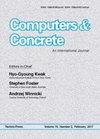Numerical finite element study of strengthening of damaged reinforced concrete members with carbon and glass FRP wraps
IF 3.3
4区 工程技术
Q2 COMPUTER SCIENCE, INTERDISCIPLINARY APPLICATIONS
引用次数: 4
Abstract
Concrete spalling is considered as one of the most common weaknesses phenomena in concrete members. In this article, reinforced concrete (RC) column and beam members are subject to a variety of loads under damaged and strengthened conditions using carbon and glass fiber reinforced polymer (FRP) wraps. The main parameters in this study include the number of the FRP layers, the materials of the strengthening FRP layers, and the loading types. The imposed loads include pure bending moment, shear, and pure torsional moment, to enable studying the structural elements's behaviors under such states. The numerical finite element (FE) model was verified using experimental results, and 10 different case numerical FE models were analyzed. The analysis results demonstrated that using an FRP layer increases the shearing and torsional capacities. Adding another FRP layer does not significantly affect the models' behavioral specifications. In both RC beam and column, this strengthening method did not affect the torsional capacity, while managed to prevent sudden capacity loss and enhance ductility.碳纤维和玻璃钢复合材料加固受损钢筋混凝土构件的数值有限元研究
混凝土剥落被认为是混凝土构件最常见的缺陷之一。在本文中,钢筋混凝土(RC)柱和梁构件在使用碳纤维和玻璃纤维增强聚合物(FRP)包层的损伤和加固条件下承受各种荷载。本研究的主要参数包括FRP层数、加固FRP层材料和加载类型。施加的荷载包括纯弯矩、剪切和纯扭转,以便研究结构单元在这些状态下的行为。利用实验结果对数值有限元模型进行了验证,并对10种不同情况下的数值有限元模型进行了分析。分析结果表明,采用玻璃钢层可以提高结构的抗剪和抗扭能力。再添加一层FRP对模型的性能指标影响不显著。在钢筋混凝土梁和柱中,这种加固方法既不影响抗扭能力,又防止了承载力的突然损失,提高了延性。
本文章由计算机程序翻译,如有差异,请以英文原文为准。
求助全文
约1分钟内获得全文
求助全文
来源期刊

Computers and Concrete
工程技术-材料科学:表征与测试
CiteScore
8.60
自引率
7.30%
发文量
0
审稿时长
13.5 months
期刊介绍:
Computers and Concrete is An International Journal that focuses on the computer applications in be considered suitable for publication in the journal.
The journal covers the topics related to computational mechanics of concrete and modeling of concrete structures including
plasticity
fracture mechanics
creep
thermo-mechanics
dynamic effects
reliability and safety concepts
automated design procedures
stochastic mechanics
performance under extreme conditions.
 求助内容:
求助内容: 应助结果提醒方式:
应助结果提醒方式:


